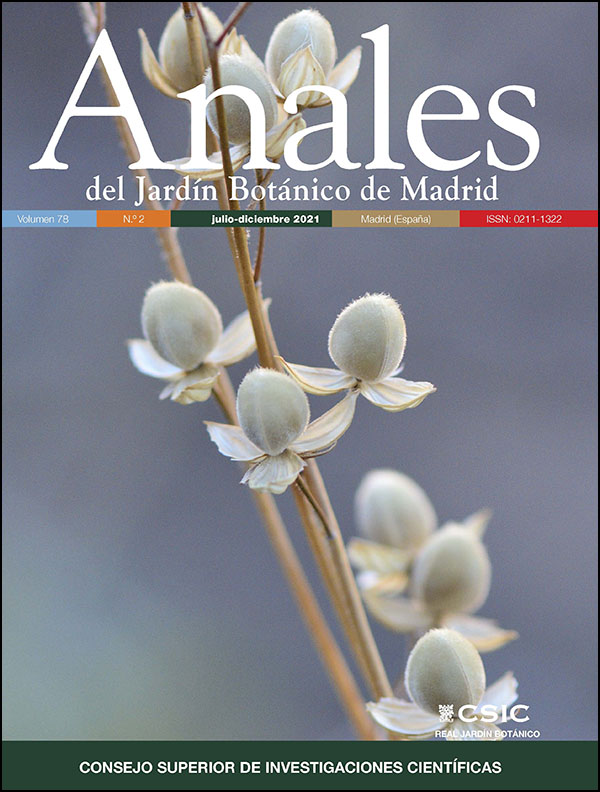Morphology, anatomy and micromorphology of the genus Oliveria (Apiaceae)
DOI:
https://doi.org/10.3989/ajbm.2588Keywords:
Anatolia, monotypic genus, Iran, Iraq, pollen, TurkeyAbstract
Oliveria is a little-known, monotypic genus of the family Apiaceae. The only accepted species, O. decumbens, is distributed throughout Mesopotamia. It is an annual, aromatic plant that has been used in traditional medicine since ancient times. The aim of this study was to examine morphological, micromorphological, and anatomical characters of O. decumbens in order to increase the current botanical knowledge of this genus.
Downloads
References
Ahmad B.S., Talou T., Saad Z., Hijazi A., Cerny M., Kanaan H., Chokr A. & Merah O. 2018. Fennel oil and by-products seed characterization and their potential applications. Industrial Crops & Products 111: 92-98. https://doi.org/10.1016/j.indcrop.2017.10.008
Alizadeh-Behbahani B., Tabatabaei-Yazdi F., Vasiee A. & Mortazavi S.A. 2018. Oliveria decumbens essential oil: chemical compositions and antimicrobial activity against the growth of some clinical and standard strains causing infection. Microbial Pathogenesis 114: 449-452. https://doi.org/10.1016/j.micpath.2017.12.033 PMid:29241765
Amin G, Sourmaghi M.S., Zahedi M., Khanavi M. & Samadi N. 2005. Essential oil composition and antimicrobial activity of Oliveria decumbens. Fitoterapia 76: 704-707. https://doi.org/10.1016/j.fitote.2005.06.009 PMid:16253439
Amiri H., Lari Yazdı H., Dosti B. & Samsamnia F. 2011. Essential oil composition and anatomical study of Oliveria decembens. Iranian Journal of Medicinal and Aromatic Plants 26: 513-520.
Bentham G. 1867. Umbelliferae. In Bentham G. & Hooker J.D. (eds.), Genera plantarum 1: 859-931. Reeve, London.
Boissier, E. 1872. Oliveria Hoffm. In Boissier E. (ed.), Flora orientalis 2: 894. Geneva et Basileae.
Candolle A.P. 1830. Umbelliferae. In Candolle A.P (ed.), Prodromus systematis naturalis regni vegetabilis 4: 55-250. Treüttel & Würtz, Paris.
Callmander M.W., Durbin O.D., Lack H.W., Bungener P., Martin P., Gautier L. 2017. Etienne-Pierre Ventenat (1757-1808) and the gardens of Cels and Empress Joséphine. Candollea 72: 87-132. https://doi.org/10.15553/c2017v721a8
Eftekhari M., Ardekani M.R.S., Amin M., Attar F., Akbarzadeh T., Safavi M., Elahe Karimpour-Razkenari, Amini M., Isman M. & Khanavi M. 2019. Oliveria decumbens, a bioactive essential oil: chemical composition and biological activities. Iranian Journal of Pharmaceutical Research 18: 412-421.
Erdtman G. 1952. Pollen morphology and Plant taxonomy I. Angiosperms. Almqvist & Wikshell, Stockholm. https://doi.org/10.1080/11035895209453507
Jiménez-Mejías P. & Vargas P. 2015. Taxonomy of the tribe Apieae (Apiaceae) revisited as revealed by molecular phylogenies and morphological characters. Phytotaxa 212: 57-79. https://doi.org/10.11646/phytotaxa.212.1.2
Mahboubi M., Feizabadi M.M., Khamechian T., Kazempour N., Razavi Zadeh M., Sasani F. & Bekhradi M. 2016. The effect of Oliveria decumbens and Pelargonium graveolens on healing of infected skin wounds in mice. World Journal of Plastic Surgery 5: 259-264.
Matthews V.A. 1972. Oliveria. In Davis P.H. (ed.) Flora of The Turkey and the East Aegean Islands 4: 425-426. Edinburgh University Press, Edinburgh.
Mousavi S., Mozaffarian V., Mummenhoff K., Downie S.R. & Zarre S. 2020. An updated lineage-based tribal classification of Apiaceae subfamily Apioideae with special focus on Iranian genera. Systematics and Biodiversity 19: 89-109. https://doi.org/10.1080/14772000.2020.1834002
Perveen A, Qaiser M. 2006. Pollen Flora of Pakistan-XLVIII. Umbelliferae. Pakistan Journal of Botany 38: 1-14.
Rechinger K.H. & Hedge I.C. (eds.) 1987. Flora Iranica 162. Akademische Druck und Verlagsanstalt, Graz.
Sajjadi S.E. & Hoseini S.A. 2002. Essential oil constituents of Oliveria decumbens Vent. Journal of Essential Oil Research 14: 220-21. https://doi.org/10.1080/10412905.2002.9699828
Sales F. & Hedge I.C. 2013. Generic endemism in South-West Asia: an overview. Rostaniha 14: 22-35.
Ventenat E.P. 1800-1803. Description des Plantes Nouvelles et peu connues, cultivées dans le jardin de J. M. Cels. De L'Imprimerie de Crapelet, Paris. https://doi.org/10.5962/bhl.title.66285
Published
How to Cite
Issue
Section
License
Copyright (c) 2021 Consejo Superior de Investigaciones Científicas (CSIC)

This work is licensed under a Creative Commons Attribution 4.0 International License.
© CSIC. Manuscripts published in both the print and online versions of this journal are the property of the Consejo Superior de Investigaciones Científicas, and quoting this source is a requirement for any partial or full reproduction.
All contents of this electronic edition, except where otherwise noted, are distributed under a Creative Commons Attribution 4.0 International (CC BY 4.0) licence. You may read the basic information and the legal text of the licence. The indication of the CC BY 4.0 licence must be expressly stated in this way when necessary.
Self-archiving in repositories, personal webpages or similar, of any version other than the final version of the work produced by the publisher, is not allowed.















